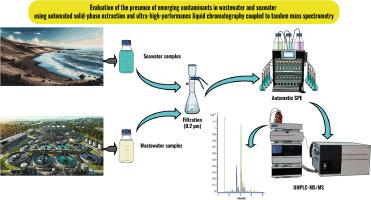利用自动固相萃取和超高效液相色谱-串联质谱法评估废水和海水中新出现污染物的存在
IF 3.2
引用次数: 0
摘要
水中新出现的污染物是人类接触这些污染物的主要途径之一,会对健康造成严重影响。从这个意义上说,通过适当的处理方法充分消除这些污染物起着至关重要的作用,因此有必要对污水处理厂的污水以及污水排放附近的区域进行监测。本研究的目的是开发和验证一种分析方法,利用自动固相萃取系统和超高效液相色谱耦合串联质谱仪测定废水和海水样本中新出现的 15 种有机污染物。基质匹配校准显示出良好的线性关系,测定系数≥ 0.990。同样,基质效应评估显示,几乎所有的分析物都存在明显的信号抑制现象,这表明在对分析物进行适当定量时需要考虑基质效应。大多数分析物的回收率在 74.7%至 109%之间,相对标准偏差值小于 20.5%。在海水和废水样品中,至少有一个样品检测到了 11 种目标分析物,其浓度从低于方法的定量限到 217 ± 92 ng l-1(在海水中),以及高达 2340 ± 107 ng l-1(在废水中)。本文章由计算机程序翻译,如有差异,请以英文原文为准。

Evaluation of the presence of emerging contaminants in wastewater and seawater using automated solid-phase extraction and ultra-high-performance liquid chromatography coupled to tandem mass spectrometry
The presence of emerging contaminants in water constitutes one of the main ways of human exposure to them, which can cause severe effects on health. In this sense, their adequate elimination through appropriate treatments plays a fundamental role, being necessary to monitor the effluents from wastewater treatment plants, as well as the areas close to their discharge. The aim of the present work has been the development and validation of an analytical methodology to determine 15 organic contaminants of emerging concern in wastewater as well as in seawater samples using an automated solid-phase extraction system and an ultra-high-performance liquid chromatography coupled to tandem mass spectrometry instrument. Matrix-matched calibration showed good linearity with determination coefficients ≥ 0.990. Likewise, matrix effect assessment showed a significant signal suppression in almost all the analytes demonstrating the need to consider such effect for a proper quantification of the analytes. Recovery values ranged from 74.7 to 109% with relative standard deviation values ≤ 20.5% for most analytes. Regarding seawater and wastewater samples, 11 of the target analytes were detected in, at least, one sample at concentrations from below limit of quantification of the method to 217 ± 92 ng l-1 in seawater and up to 2340 ± 107 ng l-1 in wastewater samples.
求助全文
通过发布文献求助,成功后即可免费获取论文全文。
去求助
来源期刊

Journal of chromatography open
Analytical Chemistry
CiteScore
2.50
自引率
0.00%
发文量
0
审稿时长
50 days
 求助内容:
求助内容: 应助结果提醒方式:
应助结果提醒方式:


